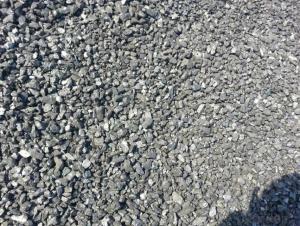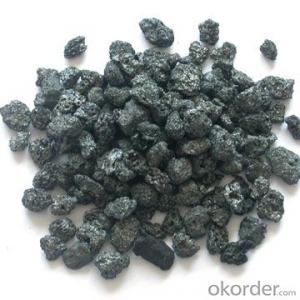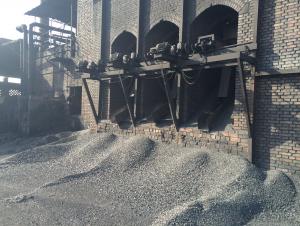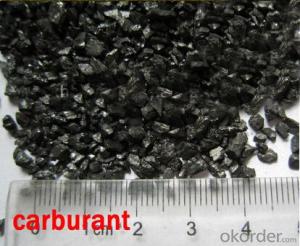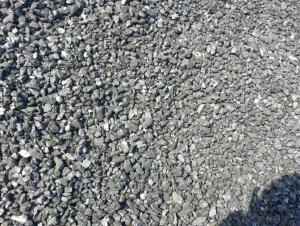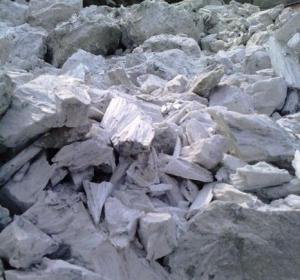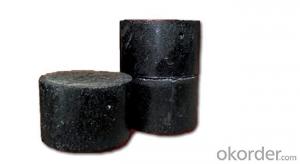Carbon Raiser FC90-95 Calcined Anthracite Coal
- Loading Port:
- Tianjin
- Payment Terms:
- TT OR LC
- Min Order Qty:
- 20 m.t.
- Supply Capability:
- 5000 m.t./month
OKorder Service Pledge
OKorder Financial Service
You Might Also Like
Packaging & Delivery
Carbon Raiser FC90-95 Calcined Anthracite Coal
25kgs/50kgs/1ton per bag or as buyer's request
Specifications
Carbon Raiser FC90-95 Calcined Anthracite Coal
Calcined Anthracite
Fixed carbon: 90%-95%
S: 0.5% max
Size: 0-3. 3-5.3-15 or as request
Carbon Raiser FC90-95 Calcined Anthracite Coal
It used the high quality anthracite as raw materials through high temperature calcined at over 2000 by the DC electric calciner with results in eliminating the moisture and volatile matter from anthracite efficiently, improving the density and the electric conductivity and strengthening the mechanical strength and anti-oxidation. It has good characteristics with low ash, low resistvity, low sulphur, high carbon and high density. It is the best material for high quality carbon products.
Advantage:
Carbon Raiser FC90-95 Calcined Anthracite Coal
1. strong supply capability
2. fast transportation
3. lower and reasonable price for your reference
4.low sulphur, low ash
5.fixed carbon:95% -90%
6..sulphur:lower than 0.3%
General Feature:
Carbon Raiser FC90-95 Calcined Anthracite Coal
| FC | 95 | 94 | 93 | 92 | 90 |
| ASH | 4 | 5 | 6 | 6.5 | 8.5 |
| V.M. | 1 | 1 | 1 | 1.5 | 1.5 |
| S | 0.3 | 0.3 | 0.3 | 0.35 | 0.35 |
| MOISTURE | 0.5 | 0.5 | 0.5 | 0.5 | 0.5 |
Pictures
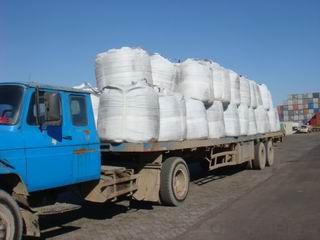
- Q:How does carbon impact the stability of desert ecosystems?
- Carbon can impact the stability of desert ecosystems through various mechanisms. Increased carbon dioxide (CO2) levels in the atmosphere due to human activities, such as burning fossil fuels, can contribute to climate change, leading to higher temperatures and altered precipitation patterns in deserts. These changes can disrupt the delicate balance of desert ecosystems, affecting the availability of water and resources for plants and animals. Additionally, excessive carbon emissions can contribute to desertification, as increased CO2 can stimulate the growth of invasive plant species, which outcompete native vegetation and disrupt the ecosystem's biodiversity. Therefore, carbon plays a significant role in destabilizing desert ecosystems and should be managed to ensure their long-term sustainability.
- Q:How does carbon dioxide affect the pH of seawater?
- Carbon dioxide affects the pH of seawater by causing it to become more acidic. When carbon dioxide dissolves in seawater, it reacts with water molecules to form carbonic acid. This carbonic acid then dissociates into hydrogen ions (H+) and bicarbonate ions (HCO3-), which increases the concentration of hydrogen ions in the water. The increase in hydrogen ions leads to a decrease in pH, making the seawater more acidic. This process is called ocean acidification. Ocean acidification can have detrimental effects on marine organisms, such as coral reefs, shellfish, and other marine life that depend on calcium carbonate for their shells or skeletons. It can also disrupt the balance of marine ecosystems and impact various ecological processes in the ocean.
- Q:What are the impacts of carbon emissions on human health in developing countries?
- The impacts of carbon emissions on human health in developing countries can be significant. Exposure to high levels of carbon emissions, particularly from sources such as vehicle exhaust, industrial pollution, and inefficient cooking fuels, can lead to various health problems. These include respiratory issues like asthma, bronchitis, and lung cancer, as well as cardiovascular diseases, allergies, and compromised immune systems. Additionally, carbon emissions contribute to the formation of smog and air pollution, which further worsen these health conditions. Developing countries often lack the resources and infrastructure to effectively mitigate these emissions, making their populations more vulnerable to the adverse health effects of carbon emissions.
- Q:A carbon Roast Lamb Leg stores need to how much money
- More than 40 thousand. If the scale is not large. If you want a prime location. And anything that's up to standard. Plus twenty thousand. If that's all. Buy something to ten thousand.
- Q:How does carbon impact the stability of ecosystems?
- Carbon is a crucial element that plays a significant role in the stability of ecosystems. It impacts ecosystems in various ways, both directly and indirectly. Firstly, carbon is an essential component of all living organisms. It is a key building block of organic molecules such as carbohydrates, proteins, and lipids, which are vital for the growth and development of plants and animals. Carbon is the primary source of energy for organisms through the process of photosynthesis, where plants convert carbon dioxide into glucose. This energy is then passed on through the food chain, sustaining the entire ecosystem. Therefore, the availability of carbon directly influences the productivity and stability of ecosystems. Furthermore, carbon dioxide (CO2) is a greenhouse gas that is naturally present in the Earth's atmosphere. It plays a crucial role in regulating the Earth's temperature by trapping heat and preventing it from escaping into space. However, human activities, particularly the burning of fossil fuels, have significantly increased the concentration of CO2 in the atmosphere, leading to a phenomenon known as global warming. This rapid increase in carbon emissions has resulted in climate change, which has severe consequences for ecosystems. Climate change impacts ecosystems in various ways. Rising temperatures affect the distribution and behavior of species, altering their habitats and migration patterns. As a result, some species may struggle to adapt, leading to imbalances in predator-prey relationships and disruptions in the overall biodiversity of ecosystems. Additionally, climate change can cause extreme weather events such as hurricanes, droughts, and floods, which can have devastating effects on ecosystems. These events can disrupt the availability of resources, destroy habitats, and even lead to the extinction of certain species. Furthermore, increased carbon dioxide levels in the atmosphere have also led to ocean acidification. When CO2 dissolves in seawater, it forms carbonic acid, which lowers the pH of the ocean. This acidification has adverse effects on marine organisms such as corals, shellfish, and other calcifying organisms that rely on calcium carbonate to build their shells or skeletons. The reduced availability of carbonate ions in the ocean makes it harder for these organisms to form and maintain their structures, ultimately impacting the stability of marine ecosystems. In conclusion, carbon has a significant impact on the stability of ecosystems. Its availability and concentration directly affect the productivity and energy flow within ecosystems. Moreover, human-induced carbon emissions have led to climate change and ocean acidification, which pose severe threats to the balance and functioning of ecosystems. Therefore, understanding and managing carbon levels in the environment is crucial for maintaining the stability and sustainability of ecosystems.
- Q:What are fossil fuels and how are they formed?
- Fossil fuels are natural energy resources derived from the remains of ancient plants and animals that lived millions of years ago. They are formed through a long process involving the decomposition and conversion of organic matter under high pressure and temperature over geological time. This transformation results in the formation of coal, oil, and natural gas, which are the primary types of fossil fuels.
- Q:How does carbon impact air quality?
- Carbon can have a significant impact on air quality through the release of carbon dioxide (CO2) and other carbon-based pollutants into the atmosphere. The burning of fossil fuels, such as coal, oil, and natural gas, releases large amounts of carbon dioxide, which is a greenhouse gas responsible for climate change. Increased levels of carbon dioxide in the atmosphere contribute to the warming of the Earth's surface, leading to adverse effects on air quality. Furthermore, carbon-based pollutants, including carbon monoxide (CO) and volatile organic compounds (VOCs), can be emitted during the incomplete combustion of fossil fuels or other organic materials. These pollutants have harmful effects on human health and can contribute to the formation of ground-level ozone, a major component of smog. Ozone can cause respiratory problems, lung damage, and worsen existing respiratory conditions such as asthma. Additionally, carbon particles, known as black carbon or soot, are released from the burning of fossil fuels, biomass, and other organic matter. These particles can directly impact air quality by absorbing sunlight and reducing visibility. Moreover, when these particles are inhaled, they can penetrate deep into the lungs, causing respiratory issues and potentially leading to long-term health problems. Reducing carbon emissions is crucial for improving air quality and mitigating the negative impacts on human health and the environment. Transitioning to cleaner and more sustainable energy sources, such as renewable energy, can help reduce carbon emissions and improve air quality. Implementing stricter regulations and emission standards for industries and vehicles can also contribute to reducing carbon pollution and improving overall air quality.
- Q:Process for producing carbon fiber board
- Method for making carbon fiber sheet:1, first determine the thickness of the plate to be made2 calculate the required number of plies according to the thickness3, and then according to 0 degrees, 45 degrees, 90 degrees, -45 degrees in the order of stacking.4, and then molding it!Now carbon fiber board, in fact, many in the middle are entrained with some glass fiber cloth, of course, there are all carbon, a little more expensive!
- Q:What is carbon offsetting in aviation?
- Carbon offsetting in aviation refers to the practice of compensating for the greenhouse gas emissions produced by aircraft by investing in projects that reduce or remove an equivalent amount of carbon dioxide from the atmosphere. This voluntary measure aims to mitigate the environmental impact of air travel by supporting initiatives such as renewable energy projects or reforestation efforts.
- Q:What are the different types of carbon-based plastics?
- There are several different types of carbon-based plastics, each with unique properties and applications. Some common types include: 1. Polyethylene (PE): This is the most widely used plastic and can be found in various forms such as high-density polyethylene (HDPE) and low-density polyethylene (LDPE). PE is known for its strength, flexibility, and resistance to chemicals, making it suitable for applications like packaging, pipes, and toys. 2. Polypropylene (PP): PP is another popular plastic known for its high melting point, chemical resistance, and durability. It is commonly used in automotive parts, appliances, and packaging. 3. Polystyrene (PS): PS is a rigid plastic that is often used in disposable products like food containers and packaging materials. It is lightweight and has good insulation properties. 4. Polyvinyl Chloride (PVC): PVC is a versatile plastic that can be rigid or flexible depending on its formulation. It is commonly used in construction materials, pipes, cables, and vinyl flooring. 5. Polyethylene Terephthalate (PET): PET is a strong and lightweight plastic that is commonly used in beverage bottles, food packaging, and textile fibers. It is known for its excellent gas and moisture barrier properties. 6. Polycarbonate (PC): PC is a transparent plastic known for its high impact resistance and heat resistance. It is often used in eyewear, automotive parts, and electronic devices. These are just a few examples of carbon-based plastics, and there are many other variations and blends available in the market. The choice of plastic depends on its intended application, desired properties, and environmental considerations.
1. Manufacturer Overview |
|
|---|---|
| Location | |
| Year Established | |
| Annual Output Value | |
| Main Markets | |
| Company Certifications | |
2. Manufacturer Certificates |
|
|---|---|
| a) Certification Name | |
| Range | |
| Reference | |
| Validity Period | |
3. Manufacturer Capability |
|
|---|---|
| a)Trade Capacity | |
| Nearest Port | |
| Export Percentage | |
| No.of Employees in Trade Department | |
| Language Spoken: | |
| b)Factory Information | |
| Factory Size: | |
| No. of Production Lines | |
| Contract Manufacturing | |
| Product Price Range | |
Send your message to us
Carbon Raiser FC90-95 Calcined Anthracite Coal
- Loading Port:
- Tianjin
- Payment Terms:
- TT OR LC
- Min Order Qty:
- 20 m.t.
- Supply Capability:
- 5000 m.t./month
OKorder Service Pledge
OKorder Financial Service
Similar products
New products
Hot products
Hot Searches
Related keywords

